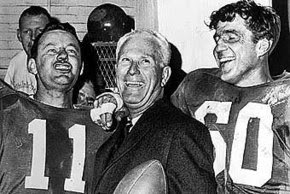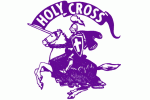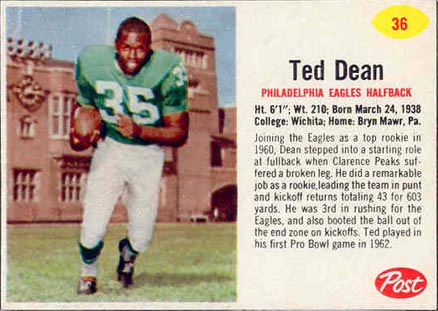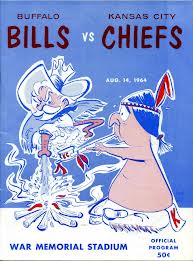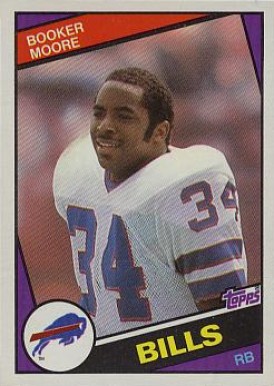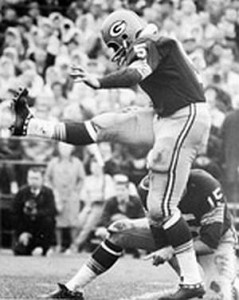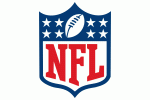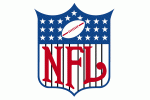This is the memorial logo being worn by the Buffalo Bills in 2014 in honor of their late founder and owner Ralph C. Wilson, Jr. Wilson was one of the original eight owners who founded the American Football League, which began play in 1960. He was the last survivor of that group, known collectively as “The Foolish Club” for having the audacity to challenge the established NFL. He also played an important behind-the-scenes role in helping to bring about the merger between the AFL and NFL which produced the thriving entity the league has become today.
Archive for November, 2014
Classic Sports Card of The Day
1963 Fleer football card of former pro football lineman Ken Rice, who played seven seasons in the American Football League for three different teams. He was an AFL All Star in his rookie season of 1961 with the Buffalo Bills. He moved on to Oakland in 1964, and was left unprotected by the Raiders in the 1966 expansion draft, and was chosen by the Miami Dolphins. Injuries forced him to retire after the 1967 season.
Classic Team Logo of The Day
Logo of a small college football program, the Holy Cross Crusaders, used from 1966 until 1998. The team plays in the Patriot League, a Football Championship Sub-division conference (formerly known as Division I-AA). Former Crusaders who’ve played pro football in either the AFL or NFL include Hall of Famer George Connor, Bob Dee, Doug Cosbie , Vince Promuto and Jon Morris.
Classic Sports Card of The Day
1962 Post Cereal football card of former NFL halfback Ted Dean. This series was available on the back of boxes of Post cereal products. Dean was a prize rookie on the Philadelphia Eagles’ 1960 championship team, as a runner, kick returner and placekicker. He scored the winning touchdown in that season’s title game. Although considered a rising star, Dean played for the Eagles for only four seasons before injuries curtailed his production, and he was traded to Minnesota prior to the 1964 season. However, he suffered further injuries in an automobile accident and only played in 2 games for the Vikings. He became a teacher in the Philadelphia area after his playing career ended.
NFL – Bills’ Game Review
For the second season in a row, the Buffalo Bills outplayed the Kansas City Chiefs for most of the day, then proceeded to hand them a win with what now has to be considered “Buffalo Bills football – 2014 edition” – that is, combining costly mistakes, questionable coaching decisions and breakdowns at the worst possible crucial times to snatch defeat from the jaws of victory. The Bills blew a 13-3 lead in the second half and lost 17-13. Buffalo’s offensive effort was average, as they struggled to run the ball at times, but had success running at others. Kyle Orton completed some impressive throws at times, and missed the mark on some others. It could be argued that the Bills played well enough on offense, defense and special teams to win the game, but were done in by the two things that have hampered them in the 1 1/2 year Doug Marrone regime – turnovers and penalties. The two turnovers were game-changers, and underscored why the Bills are still the same old Bills, despite what their players say. Bryce Brown took off on what looked like a sure touchdown run only to have the ball knocked loose at the four yard line. The ball bounced directly into the hands of tight end Scott Chandler, but he lost the handle on it and allowed it to bounce out of the end zone for a touchback. After the Bills’ defense made a stand, Leodis McKelvin wiped out whatever momentum that stand might have given his team by fumbling the Chiefs’ punt. Did the Bills’ supposedly dominant defense stiffen up and bail out McKelvin? No, two plays later, the Chiefs were in the end zone on an eight yard Alex Smith run for what turned out to be the game-winning touchdown. It’s tough to assign any blame for the defeat on the defense, since they pressured Smith most of the day, sacking him six times, and contained K.C. back Jamaal Charles for the most part. However, at the most crucial points of the game in the second half, they allowed Charles to run 39 yards for a score on fourth down and one, and allowed an 18 yard scamper by Charles right after McKelvin’s fumble. Again, the Bills played what has become their “signature” game – they played well enough to win but gave the game away. It’s that maddening habit that keeps them from getting any respect from the national media, why they aren’t considered real contenders and why, against the New York Jets in their last game, they became the first team with a winning record in NFL history to be an underdog against a team with one win. Most of the pro football experts know what to expect from this team – that they’ll collapse at critical times during games and at some point every season, and the Bills feed that lack of respect by continually delivering those collapses.
Other than letting a sure win get away, did the Bills accomplish anything positive on Sunday? Absolutely they did. After a slow start, their running game started to click, with Brown and Anthony Dixon grinding out good chunks of yardage. The offensive line had a decent game, blocking well enough for the backs to total 111 yards and allowing only a single sack on Orton. McKelvin, before his disastrous fumble, set up the offense in good field position with some nice punt returns. The defense, other than the pair of breakdowns involving Charles, had another good day, sacking Smith six times, with three coming from Marcell Dareus, who is now establishing himself as a solid Pro Bowl-caliber player.
Classic Team Logo of The Day
Today’s logo is another example of the great cartoon art featured on the American Football League’s game day programs in the 1960s. This program was from a pre-season game played on August 14, 1964 between the Buffalo Bills and Kansas City Chiefs, and shows the “Buffalo Bill” logo that was used on many of the Bills’ programs at the time, dousing the campfire of a pretty sorry-looking Chief.
Classic Sports Card of The Day
1984 Topps football card of former Buffalo Bills running back Booker Moore, who was drafted by the Bills out of Penn State in 1981, but was forced to sit out a year after he was diagnosed with Guillain-Barre syndrome. He was able to play again in 1982 and wound up playing four mostly uneventful seasons for the Bills in the Chuck Knox era. After retiring in 1986, Moore became a sheriff’s deputy in Michigan. He died of a heart attack at the age of 50 in 2009.
Classic Team Logo of The Day
On the left is the iconic logo of the National Football League, unofficially known as “The Shield”, and on the right is the same logo as it appeared when first introduced in 1960. Obviously, it’s not a “team” logo, but the NFL itself, in the early years under commissioner Pete Rozelle, became somewhat of a team as the team owners, under Rozelle’s guidance, incorporated as one and negotiated huge television contracts that called for revenue sharing and ensured even the small market franchises could remain solvent and competitive. It was a brilliant strategy that helped grow the game into the media giant that it is today.


